COVER- Welcome to town, but watch the traffic
U2 is playing just 20 times in North America. Populous states like Ohio, Pennsylvania, and Michigan got bypassed, and gigantic California got limited to a single show at the Rose Bowl. But what may be the most popular band in the world did, however, pick Charlottesville. Or was it the other way around?
The promoter for Live Nation, Tres Thomas, lives in Ivy. We haven't heard back from him by press time, but, like that time in 2005 when he brought the Rolling Stones here, you can be sure he's arguing for business necessity– not his own convenience. After all, this is a man who commutes weekly to his office in Toronto.
Hey, isn't Toronto a two-night-stand for the boys from Dublin? Indeed it was.
Well, anyway, Charlottesville is ready. As Stephanie Garcia reports, concert general manager Larry Wilson has a traffic copter flying to ensure there's no repeat of the ginormous jam that accompanied the Stones gig. After all, some cynics believe it was a stuck motorist unhappy about missing Jumping Jack Flash who called in the bomb scare. (All the police would confirm was that the call did come from Pantops.)
Anyway, in the name of love... read on!
A U2 glossary: Or how to smarm your way backstage
BY LINDSAY BARNES
Mount Temple Comprehensive School: The suburban Dublin school where all four members met when 14-year-old drummer Larry Mullen, Jr. placed an announcement on the school's notice board that he sought musicians to start a band.
Dik Evans: Older brother of guitarist The Edge (born David Evans), and the fifth member of the group when they began as Feedback, and then changed their name to The Hype. When Evans left the group for art college, the band became a quartet, and re-named themselves U2.
Max Quad Band: This Irish new wave outfit was the first band in which bassist Adam Clayton was a member. Clayton was reportedly fired for not knowing how to play.
Ali Hewson: High school sweetheart of the young Paul Hewson, who on August 21, 1982, became the wife of the man known as Bono. Twenty-seven years later, they're still married and have four children: 20-year-old daughter Jordan, 17-year-old daughter Memphis Eve, 10-year-old son Elijah, and eight-year-old son John.
"Show Me the Way": This Peter Frampton tune was the first song Bono, Edge, Adam, and Larry ever performed in front of an audience, at Mount Temple in October 1976. Their set consisted entirely of covers, including a Beach Boys medley, and not one, but two performances of the Bay City Rollers' "Bye Bye Baby."
1976 Gibson Explorer: The guitar with which The Edge has had a love affair since he bought it at age 17. In the documentary This Might Get Loud, he says that the first time he saw his beloved six-string in the window of a music shop, "This instrument was just calling out to me." He's played it on U2 albums and in concert ever since.
Neil McCormick: Music critic for the London Daily Telegraph and school chum of the band's at Mount Temple. He formed his own group concurrent with the formation of the band that would be U2, which, after years of struggling to be heard, split up while watching his contemporaries rocket to international superstardom. He chronicled the story in the 2004 book, Killing Bono: A True Story. No hard feelings between the two, though. Bono wrote the book's foreword, and McCormick edited the band's 2007 autobiography U2 by U2.
Paul McGuinness: What Coran Capshaw is to Dave Matthews Band, he is to U2. Since relieving Adam as the band's manager in 1978, he has been a part of the U2 family ever since, to the point where the rest of the band refers to him as their "fifth member."
Steve Lillywhite: Something DMB and U2 have in common is that each had their debut album produced by Steve Lillywhite: U2's Boy in 1980 and DMB's Under the Table and Dreaming in 1994.
The Ritz: The New York theater where the band made their American debut on December 6, 1980. It still stands at 125 East 11th Street, now known as Webster Hall.
Slane Castle: The 18th century Irish castle where U2 recorded the initial sessions for their 1984 album The Unforgettable Fire. They would return to the castle in 2001 for a performance on the grounds before more than 100,000 fans, a concert recorded in the live DVD U2 Go Home: Live from Slane Castle.
Republic Liquor Store: Located at the corner of Seventh Street and Main Street in downtown Los Angeles, it's the rooftop where U2 spontaneously played live on March 27, 1987, and shot the video for "Where the Streets Have No Name" until they were shut down by police.
Harley-Davidson: If there's one thing Larry loves more than drumming for U2, it's Harley-Davidson motorcycles. He owns a fleet of them that he keeps in the garage of his home in the Dublin suburb of Howth, and can be seen straddling a bike that once belonged to Elvis Presley in the U2 concert documentary Rattle and Hum.
Morleigh Steinberg: This American choreographer's history with the band dates all the way back to the 1993 Zoo TV tour. Each night she made an appearance as a belly dancing temptress meant to seduce Bono during the performance of the Achtung Baby hit "Mysterious Ways." Perhaps her feminine wiles worked better than originally intended. After a nine-year courtship, she married The Edge in 2002.
Trabant: Cheap cars from this defunct East German automaker were a visual fascination for the band in the early to mid '90s. Not only did the video for "One" feature several elaborately painted Trabants, but 11 Trabants hung from various scaffoldings on the set of the Zoo TV tour, now on exhibition in the Rock 'n Roll Hall of Hame in Cleveland.
Lemon mirrorball: 40-foot-high stage prop from which the band members would emerge onstage at the start of the encore during the band's 1997 PopMart Tour. Bono intended it to be an homage to Parliament-Funkadelic's spaceship. This was one of the many extravagances of the set that put the band $20 million in debt by tour's end. Nevertheless, Bono still says its the band's best tour and calls it "our finest hour."
Wim Wenders: The German filmmaker is a longtime collaborator with U2. The band has written the title tracks to three of Wenders' features: 1991's Until the End of the World, 1993's Faraway, So Close, and 2000's The Million Dollar Hotel, for which and co-wrote the screenplay.
Jeremiah 33:3: The Bible verse Bono snuck into the cover art for 2001's All That You Can't Leave Behind, superimposing "J33-3" over a sign hanging in the background of the shot of the band standing in the terminal of Paris' Charles de Gaulle International Airport. The verse, which Bono has called "God's phone number," reads "Call to me and I will answer you, and will tell you great and hidden things that you have not known."
Arcade Fire: The up-and-coming Montreal indie rockers are a personal favorite of U2. Each night of the 2005 Vertigo Tour, they took the stage to the tune of the band's "Wake Up."
Fez: Despite Edge's predilection for wearing toques, this does not refer to Arabian headgear. Rather, it's the city in Morocco where U2 holed up in a local hotel and recorded much of their latest album No Line on the Horizon in the hotel's central courtyard.
Spider-Man: What could the Marvel comic book hero and the Irish rockers possibly have in common? Bono and Edge are currently working on songs Spider-Man: Turn Off the Dark, a Broadway musical set to debut February 25, 2010. What's the attraction to the story of Peter Parker? "Every rock and roll star probably started out as the geek who got bullied on in school," Bono told Rolling Stone in June. "and eventually their form of revenge was to write songs or learn to play guitar."
Blackberry: Despite the fact that Apple put out a U2 edition of the iPod in 2005, don't think that Bono, Edge, Adam, and Larry are exclusively iPhone men. Blackberry is the sponsor for the 360° Tour.
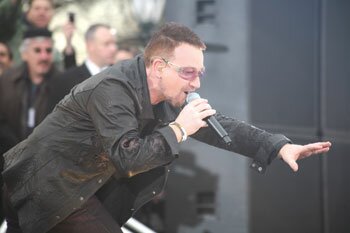
Bono of U2
Photo by WFUV
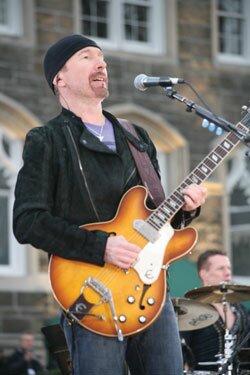
Guitarist The Edge of U2
Photo by WFUV
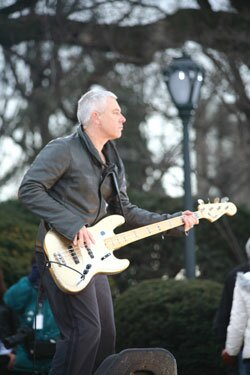
Adam Clayton of U2
Photo by WFUV
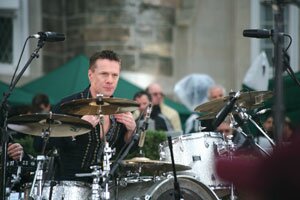
Larry Mullen, Jr. of U2
Photo by WFUV
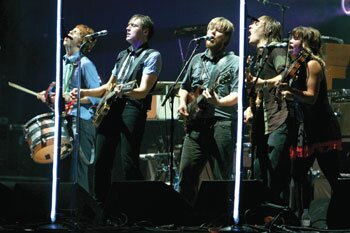
My boss Bono: Local man was singer's right-hand man on Africa
BY LINDSAY BARNES
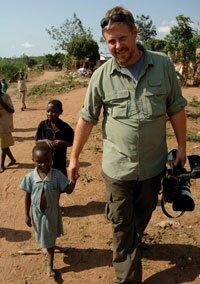
J. Tayloe Emery's travels working for Bono and the ONE Campaign took him all over Africa, including this trip to Tanzania.
COURTESY J. TAYLOE EMERY
For the better part of the last three decades, when Bono hasn't been recording and touring as the lead singer for the world's biggest rock band, he's been throwing the full weight of his time, money, and celebrity behind the cause of eradicating extreme poverty on the African continent. Beginning with his work to help organize the Live Aid concerts of 1985, to then founding his own non-profits in the early '00s, to now lobbying heads of state all over the world, Bono's message of debt relief and aid to developing African nations has been a more constant a drumbeat than anything that has ever appeared on a U2 album.
For the last five years, the man responsible for assuring the world would hear Bono's clarion call was a Charlottesville man who, before meeting the Irish rocker, was living on the Downtown Mall and writing for music magazines.
"I was living in an apartment in the Jefferson Theater, doing freelance writing," recalls J. Tayloe Emery, who now operates his own creative consulting firm. "I got a call from D.C. saying that Bono was starting this thing, and did I want to move there and manage all the creative stuff."
"This thing" was a group called DATA– standing for "debt, AIDS, trade, Africa." Eventually folded into the well-known One campaign, the group would raise popular support for the most prominent issues facing the continent of mostly developing nations.
And when they were looking for a creative director, says Emery, Bono's aides in Washington found him through the work he'd done just prior to taking up residence in Charlottesville.
"When I was out in Seattle, I had done publicity for R.E.M. and Pearl Jam when they were trying to buy up all this land to save some of the forests from the timber companies," says Emery. "So they knew right away that I had experience with celebrities to get them on board."
That would be tested in Emery's first week on the job in Washington as the group's creative manager.
"In one of my first assignments with Bono," recalls Emery, "he tells me he's just gotten done talking to Brad Pitt, and would I go meet with him and get him to go to Africa and get him on the hook."
Soon enough, Emery was on a plane to Ethiopia with the megawatt movie star, the first of many sojourns to Africa with the likes of actors Matt Damon and Ben Affleck, New England Patriots quarterback Tom Brady, and camera crews from ABC and NBC. But never had Emery come to know his boss so well as when he accompanied Bono to the continent.
"What people don't realize is that he's an incredibly funny guy, which means he's able to put everyone at ease," says Emery. "I remember one time we were at an airport in Mali, and we're running late, and we're all scrambling. Suddenly, he just breaks into this aria from some opera. We all break up laughing and calm down."
Bono applies his people skills not only to his employees, but also to the men and women in the highest seats of power in Washington. Both Republicans and Democrats, and even President George W. Bush, have met with the rock star to discuss foreign aid to African nations– a testament, Emery says, to Bono's personal magnetism.
"When U2 started he set out to be the world's biggest rock star, and now that he's achieved it, he's rightfully proud of that, so he's not only a confident guy, but also happy, and very agreeable," says Emery. "He communicates with you with the same intensity that he communicates with 75,000 fans."
Yet, what Emery says has always been consistent about Bono is that his African mission has never been about his own aggrandizement.
"He always opens speeches with the idea of why would anyone listen to a rock star from Ireland talk about Africa?" says Emery. "The point is that it's not about his voice, but about what all of our voices can do together. He really just sees himself as a conduit. He figures that if the spotlight is always on him, why not let that spotlight follow him to the places where the light really needs to be shown?"
Helicopter parent: Wilson promises less traffic, eye in the sky for U2
BY STEPHANIE GARCIA
For fans of the monumental pop-rock quartet, U2, Bono– the self-appointed guru of all things politically, economically, and morally sustainable– is more than just a rock star. His activism against general injustice is appealing to admirers looking for depth and inspiration in their role models. Yet why does Bono require 104 18-wheelers and a small army to perform for said dedicated fans?
U2's 360 Tour concert may seem like more of a 180 on the band's convictions and beliefs, but in reality, putting on an epic stadium show– what concert reviewers across the country are calling, "the largest show ever to be staged by a pop group"– requires more than a few Toyota Priuses or Product Red-branded Gap apparel.
"The stage covers half of the stadium field," explains John Paul Jones arena general manager Larry Wilson. "It's the largest concert production ever assembled [here], period."
The stage, a circular platform nicknamed "The Claw" which allows for all sides of the audience to view the band at once, will be pulled into town by the aforementioned 104 trucks– a smaller battalion than the 120 trucks used in U2's earlier American stops at Chicago's Solider Field and New York's Giants Stadium. For their first stadium tour in the U.S. since 1997, U2 has chosen only the biggest and best venues (FedEx field, the Rose Bowl, the newly minted Dallas Cowboys' stadium)– and, economic recession aside, have managed to play to audiences of 60,000-65,000.
UVA's Scott Stadium hasn't yet sold out its 60,000 spots, but Wilson is confident the show will play to a full house. The stadium won't have to add more seating, but the general admission tickets (priced at $32) have fans standing on the field around the stage.
"It's the greatest show I've ever seen," Wilson says. Flying up to Boston's Gillette Stadium on September 20, Wilson snagged a preview of both the performance and the logistical set up to better prepare Charlottesville for its U2 landing. "From sound to lights to the stage– the total production was an amazing show," he says.
Charlottesville's production began early morning on Thursday, September 24, with local Skyline Tent Company setting up the crew cafeteria and kitchen area on the second floor of Scott Stadium's parking garage at 6am. Four connected tents will provide running water and kitchen facilities for the 200-plus army of people accompanying Bono. The stadium's surrounding parking facilities– usually filled with tailgaters for football games– have reserved space for approximately 20 tour buses, according to Skyline co-owner John Hingeley.
While parking immediately around the stadium is reserved for limos, buses, and select ticket holders (gold and red), other audience members can buy permits to park in various area parking lots– JPJ and University Hall, Newcomb Garage, the UVA Hospital garage, and Fontaine Avenue.
How to avoid the massive traffic jams that occurred on Interstate 64 prior to the Rolling Stones Scott Stadium show in October 2005? After all, the subsequent show-stopping bomb threat was never solved and was popularly seen as a disgruntled driver's attempt to avoid missing the show. However, Wilson reports that this time around, various precautions are in place to prevent a repeat traffic disaster.
"We've added a helicopter in the sky with a policeman to monitor traffic and make changes based on that," he says. "We plan to monitor the streets via VDOT's camera system as well."
Extra surveillance will be amplified by extra communication with attendees. Various emails have been sent directly to ticket holders; and comprehensive, colorful maps and directions have been posted on the JPJ website. Upwards of 25 message boards will be placed throughout the incoming highways and streets, and hundreds of officers will be out in full force to aid anxious motorists the day of the show.
Although Bono will be marking Charlottesville with what some consider a massive carbon footprint, the activist has also been including his political messages in earlier 360 Tour stops, according to reports. Previous concerts in Chicago and New York have seen Bono giving shout-outs to the AIDS in Africa issue, dedicating songs to jailed Burmese politician Aung San Suu Kyi, and showing a video message from Desmond Tutu, the internationally-renowed South African cleric. If Charlottesville's pre-show production bears any resemblance to its U.S. stadium predecessors, Bono is sure to deliver a similar message on October 1.
"This is Charlottesville, Virginia getting U2 to play here, the Rolling Stones to play here– it's a huge thing, and doesn't happen all the time," Wilson says. "We're very fortunate to have them here, and the show is very pleased with how things are going so far."
Bigger bang: 'Satan loves a bomb scare'
BY RAN HENRY
"Something big's going on," said an officer in UVA blue guarding the empty grass backstage, while Mick Jagger sang "Rough Justice" and bomb-sniffing dogs searched for the devil's scent.
Would a bomb explode at the Rolling Stones concert on the grounds of the University of Virginia? Was the voice calling from a pay phone at Pantops threatening real disaster or a hoax? Questions swirled in the storm clouds over Scott Stadium, on the first Thursday in October, 2005, falling on the shoulders of the men in the President's Box.
There is danger in the air, danger in our world, danger in daring to be great. Yet something big is always brewing in Charlottesville, where the stadium holds more people than the town.
On the first Thursday in October, 2009, another finalist for the title of World's Greatest Rock Band (as well as the Nobel Peace Prize) appears on a stage of biblical proportions, on a tour of 15 North American cities and one community of 40,000 souls. Of course Bono and U2 want to play where the Eagles, Bruce Springsteen, Bob Dylan and the Stones played, the Dave Matthews Band emerged from a downtown bar, and international orders for Led Zeppelin t-shirts are filled just down the tracks in Crozet.
In advance of this messianic visit, the police who safeguard our grounds, our town, our county, and our state conducted a mock evacuation of Scott Stadium in mid-September. Most don't want to talk about the night 55,000 concert-goers prepared to be ordered out. Publicity, police say, empowers the devil with a phone in his fist. Yet you can almost hear Thomas Jefferson shouting from his hilltop that silence empowers evil even more.
University Police Officer Janice Coles headed the investigation also taken up by the FBI, did all she could to close case number 200501231, and says she doesn't remember much, now, about the October night in 2005 when the Rolling Stones visited Charlottesville.
Did Jagger feel foreboding when his helicopter couldn't land at the University's hospital, when his limo broke down, and he rode to the stadium in a patrol car squawking with reports of traffic backed up for miles? He strutted out to the opening chords of "Start Me Up" at 8:48 p.m., with gunpowder already in the air. Thunder rumbled, and flames roared up from the stage.
At 8:56pm, according to the University's press release, a 911 operator received the bomb threat, when Jagger was singing "Shattered," (a song accompanied by a complete power black-out in Veteran's Stadium in Philadelphia in 1989). As Jagger sang, "this town's in tatters," the house lights on the left side of Scott Stadium inexplicably lit up.
"So nice I was able to see each and every one of your faces. That was the house light song," he ad-libbed, clearly annoyed. Then he missed singing the first line of "Tumbling Dice" because he was too far away from his mike.
Sometime before he shimmied through the Ray Charles classic, "Night Time is the Right Time," the nightmare news reached the President's Box. The dogs had turned up nothing backstage. The threat "to the stage area," as the press release put it, seemed credible to ranking officers of four different police forces. The stadium full of fans and the University were at a crossroads, after three quarters of an hour in real tough time.
At 9:43 p.m., word officially reached the stage to stop the show. Jagger looked surprised, amid his usual band introductions, eliciting a cheer for Ronnie "Rembrant" Wood as roadies moved the artistic guitarist's pedal steel to center stage. It was at the midpoint of the show, when guitarist Keith Richards sings two songs while Jagger changes costumes– the least worst point for the Stones to have their performance disrupted. Richards and drummer Charlie Watts never did get introduced. The devil certainly knows who they are. Richards grabbed his prized Telecaster and left the stage with his bandmates, shrugging at fans, driven off in a white van with police cars leading the way.
You had to wonder if Al Quaeda was at work beneath the house lights, when cell phones quit working for police as well as fans. We all wondered if the Stones would ever come back, if we would help or trample each other, if we should jump on the guy with the wires in his hat who was taping the show. Wondering about our escape route, our loved ones– and the 47 minutes between the bomb threat being called in and the silencing of the Stones.
"I'm not a bomb-dog handler," said Lieutenant Todd Hopwood, the Albemarle County Sheriff's Department's Incident Commander for U2, also in the chain of command at the Stones' show. "But I can tell you that dogs are like humans. They get tired. To keep them on focus, that time frame would make sense.
"I've been in charge of canines before," Hopwood said, "and it takes 30 to 40 minutes to sweep an area and discern the danger"– then decide to halt the highest-profile party ever thrown in Charlottesville.
What pressure on University President John Casteen, and University CEO Leonard Sandridge, up in that President's Box, from promoters, performers, and history. Through a university spokesperson, President Casteen declined to confirm or comment on having made the decision to stop the show. Lt. Hopwood, who hopes not to await the word of Casteen and Sandridge during U2's performance, says, "No doubt it was their call."
God bless them for it. No one should have to die to see the Rolling Stones.
The dogs found nothing threatening in the $350 seats, and the show that didn't seem likely to resume actually did. "Off we go," said Jagger with studied nonchalance, at 10:38 p.m. Then fireworks erupted with real heat as he sang "Sympathy for the Devil," and the threatening rain finally came. The show closed near midnight with what almost sounded like a gospel version of "Satisfaction," perhaps to placate the powers of light.
Some say we got our recompense nine days later, when the Cavaliers beat Florida State on a field sprinkled with some shade of Jagger magic. Others say you are known by the company you keep. The Stones' most famous tour began in 1972 with 2,000 fans storming the Pacific Coliseum in Vancouver, BC, hurting 31 policemen. The tour continued with riots in San Diego, Tucson, Detroit, New York and Washington, D.C., on the Fourth of July, broke for a four-day orgy at the Playboy Mansion in Chicago, resumed with a fight with a photographer that had 18,000 people in Boston Gardens waiting until midnight to rock or riot while Boston's mayor bailed out the band, and climaxed with the bomb that blew up the equipment truck in Montreal, Canada, giving police time to round up 3,000 people with fake tickets while new equipment was flown in. That drama made the band harder to serve with court papers from the family of a fan murdered in the crowd at Altamont the tour before, when Hells Angels served as security.
The Stones played the Norfolk Scope in 1972 without incident. The next three times they visited Virginia they nearly died flying into a thunderstorm, got attacked onstage during a pay-per-view concert in Hampton Coliseum, (with Richards defending himself with his Telecaster), and then had to be escorted out of Scott Stadium.
In short, our night of chaos and darkness was business as usual for the Stones. Their spokesperson's response to the trouble in Charlottesville was, "We get bomb threats every two or three shows."
Sgt. Mark Brake of the Charlottesville Police Department, who assisted fellow officers in New York after the terrorist attack on 9/11, and worked the streets on the Night of the Living Stones, will again be on duty this first Thursday in October. He was asked if the real problem behind the traffic jam, the rain, the loss of communication, the bomb threat and the black eye we got in the national news was the darkness in the music of the Stones.
"Yeah, exactly," said Sgt. Brake.
"I actually like the Rolling Stones," countered Officer Coles.
Now we're hosting four lads from Dublin, Ireland, who put Bible references in their lyrics, supply the soundtrack for modern church services, besiege politicians to support aid for Africa, and rock just as hard as any band that made a deal to play the blues. Thomas Jefferson would love to know that when author Salmon Rushdie was threatened with a Fatwah, a world-wide death sentence imposed by Islamic extremists, after the publication of The Satanic Verses, the author was welcomed at Bono's house.
"Satan loves a bomb scare," Bono will sing at Scott stadium, surrounded by 800 security guys. "But he can't scare you."
Clear skies are forecast for Thursday, followed by a Homecoming victory over Indiana.
#
3 comments
You made some good points there. I did a search on the topic and found most people will agree with your blog. Thanks
I really thankful to you for this great read!! You did a very great job, keep it up.
Interesting blog. Actually google made searching of information easy on any topic. Well keep it up and post more interesting blogs.